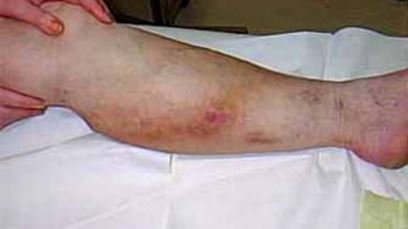Superficial Thrombophlebitis
What is superficial thrombophlebitis?
Superficial Thrombophlebitis is the blood disorder in which veins placed just beneath the skin surface get swelled up due to blood clotting. The superficial thrombophelibitis is common in legs, but it can affect the penis and breast as well.

Superficial thrombophelebitis, also originated due to intravenous catheter administration, especially at the jugular vein or other sites where prolonged intravenous administration is common. The condition is generally resolved within two to six weeks. The condition does not produce any serious health problem. The superficial thrombophlebitis rarely causes fatal condition.
Symptoms of superficial thrombophlebitis
The following are the symptoms associated with superficial thrombophlebitis:
- Inflammation
- Tenderness
- Redness
- Pain in the affected area and intensity in increased, if pressure is provided
- Skin over the vein coloration become darkens.
- Warmth
- Increase body temperature (fever)
- Vein become hard or twisted, if the blood coagulation inside the vein
- After some times, if the clot does not break or circulate then lump may produce inside the skin which can be felt by touching.
Causes
The reason behind the thrombus formation is the injury in the vascular endothelial tissues. If the injury causes the inflammation, then immediate platelet adhesion has occurred at the site of the injury. Then thromboxane A2 (TxA2) and thrombin is responsible for platelet aggregation. It is believed that for venous thrombosis, thrombin is mainly responsible.
Risk factors which promotes superficial thrombosis
The following factors considered as risk factors for developing superficial thrombosis:
- Intravenous injection
- Formation of intravenous line for administration of fluid
- Catheter insertion
- Illness which promotes blood coagulation
- Infection
- Obesity
- Older age
- Cancer chemotherapy
- Pregnancy
- Hormonal therapy
- Contraceptive pills
- Genetic reason like gene of prothrombin mutation.
Diagnosis
Firstly, doctors examining the affected area. Vital sign is also examined which include pulse rate, heart rate, blood pressure and body temperature. Then, depending upon the initial examination and discussion of the sign and symptoms, doctors may order the following tests:
- To analyze the blood flow and blood pressure, Doppler ultrasound test can perform which utilizes the sound waves for recording the information.
- For obtaining the more proper images of blood circulation, the combination of Doppler Ultrasound and Duplex Ultrasound are performed.
- Rarely venography is performed to capture the blood flow imaged through the affected vein and for this special dye is injected into the veins.
- Blood and cutaneous tissue culture are conducted for identification of the microorganism in case of infection. For collecting the sample, blood is taken out from the vein and cotton swab is used for collection of the sample of the cutaneous tissue.
- MRI and CT scans are also conducted for locating the clot inside the vein.
Treatment
The treatment of mild to moderate intensity of the superficial thrombophlebitis is home based and the condition become cured within 15 days, but take more time for hardening of the vein. .The treatment is based upon following technique
- Warm compression on the affected area which helps to dissolve the clots.
- To lessen the inflammation, it is suggested to wear the stockings for providing the supports.
- Different popular brands of Ibuprofen or aspirin or any other non steroidal anti-inflammatory drugs which are available in the pharmacy stores as OTC (over the counter) products can be taken for reducing the pain and tenderness.
- In case of varicose veins, or in serious condition, stripping, phlebectomy or sclerotherapy can be conducted to treat the condition and also to prevent the recurrence of the superficial thrombophlebitis.
Medical assistance
In case of fever with shriving and worsening the symptoms, it indicates a serious health condition and need medical assistance.
It is also possible that superficial thrmbophlebitis may develop deep vein thrmbophlebitis which can be provide breathing problem or increased heart rate require immediate medical health.
Complications
The superficial thrmbophlebitis is short term and usually not leads to causes any complications. But rarely skin infection or cellulitis may develop after superficial thrmbophlebitis. To treat this condition, antibiotics usually prescribed by the doctors depending upon the causative bacterium.
Another possible complication is deep vein thrmbophlebitis. The condition becomes fetal if the thrombus is traveled into the heart or lungs.
Varicos vein causes recurrence of superficial infection.
Prevention
There is nothing certain rule for preventing the superficial thrmbophlebitis, but certain measures can help to prevent the event, such as
Avoid prolongs sitting or lie down position. After a certain period like after 1.5 or 2 hours stretching of the lower limbs and arms is important for maintaining the blood circulation.
In case of IV line formation leads to inflammation, immediately change the site to prevent further inflammation and also superficial thrmbophlebitis.
Pictures



References
- http://emedicine.medscape.com/article/463256-overview
- http://www.healthline.com/health/superficial-thrombophlebitis#Treatment5
- https://www.nlm.nih.gov/medlineplus/ency/article/000199.htm
- http://www.mayoclinic.org/diseases-conditions/thrombophlebitis/basics/symptoms/con-20021437
- http://patient.info/health/superficial-thrombophlebitis-leaflet
- http://www.drugs.com/cg/superficial-thrombophlebitis.html
